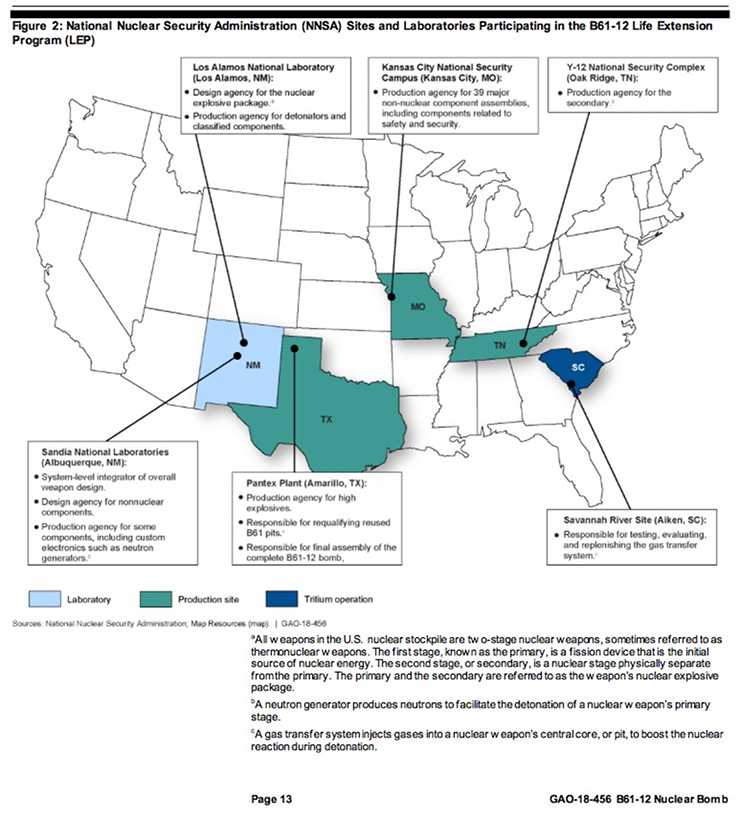The Y-12 National Security Complex in Oak Ridge is part of a program to extend the life of B61 bombs, the oldest nuclear weapons in the nation’s active stockpile, federal officials said.
The life extension program, or LEP, for the B61 bombs is the most complex and expensive since the U.S. Department of Energy began stockpile life extension activities in January 1996, according to the U.S. Government Accountability Office.
Critical components of the bombs are reaching the end of their operational lives, and the life extension program will result in a bomb known as B61-12. It will consolidate four versions of the bomb into one. The bombs could be carried on B-2A bomber aircraft and F-15E, F-16, F-35, and PA-200 fighters.
A GAO report described the role of six National Nuclear Security Administration sites and laboratories in the LEP. Besides Y-12, the NNSA sites are Kansas City National Security Campus in Missouri; Los Alamos National Laboratory in New Mexico; Pantex Plant in Amarillo, Texas; Sandia National Laboratories in Albuquerque, New Mexico; and Savannah River Site in Aiken, South Carolina.
Y-12 is designated as the production site for the secondary. All weapons in the U.S. nuclear stockpile are two-stage nuclear weapons, or thermonuclear weapons. The first stage, known as the primary, is a fission device that is the initial source of nuclear energy, the GAO said. The secondary, which is the second stage, is a nuclear stage physically separate from the primary. Together, the primary and secondary are referred to as the weapon’s nuclear explosive package, the GAO said.
The B61-12 life extension program has an expected completion date of fiscal year 2025, and a first production unit is possible in 2020, although there are questions about those dates, in addition to a variation in cost estimates, according to the GAO report. The May 31 report was addressed to the U.S. Senate Armed Services Committee.
The report said the life extension program is expected to help consolidate and replace four of the five modifications of the B61 bombs: the B61-3, B61-4, B61-7, and B61-10.
It’s also expected to improve accuracy with a new tail kit guidance assembly that will allow the bomb to be delivered with greater accuracy than the B61 bombs it replaces, which are equipped with parachutes, the GAO said.
The program will also address other age-related issues, the GAO said, extending the service life of the B61 by at least 20 years, making field maintenance of the weapon easier for Air Force technicians, and providing modern security features.
The NNSA had a formal cost estimate of $7.6 billion for the program in October 2016, according to the GAO report, which studied questions related to cost estimates and program risks. The risks included an aggressive flight test schedule for bomb delivery aircraft and the readiness and certification of the F-35 delivery aircraft.
The $7.6 billion cost estimate formalized by the NNSA is lower than an independent cost estimate of about $10 billion, the GAO said.
The B61 was first “fielded” in 1968, the GAO said, and current modifications were fielded between 1979 and 1991.
Other life extension programs
There are other life extension programs besides the B61-12, and they also involve work at Y-12. The GAO said the NNSA and U.S. Department of Defense undertake the programs to refurbish or replace aging components. The programs also enhance the safety and security of nuclear weapons, and consolidate the nation’s stockpile into fewer weapon types to reduce maintenance and testing costs—while preserving necessary military capabilities, the GAO said.
The NNSA expects to finish one of the life extension programs, the W76-1 LEP for the W76 warhead, in fiscal year 2019, which starts October 1. The first production unit in that program was completed in September 2008.
The NNSA has previously said the W76-1 Life Extension Program involves engineers, scientists, and technicians at Y-12, Los Alamos National Laboratory, National Security Campus, Pantex Plant, Sandia National Laboratories, and Savannah River Site. The halfway point of the production phase was reached more than three years ago, in October 2014, the NNSA said. Primary goals of the program are to address aging issues and extend the original warhead service life from 20 to 60 years.
The W76 warhead was first introduced into the stockpile in 1978, and it is deployed with Trident II D5 missiles on Ohio-class nuclear ballistic missile submarines.
“W76 warheads comprise a large share of the U.S. nuclear stockpile,” the GAO said.
Another life extension program, the W80-4 LEP, is intended to provide a warhead for a future long-range “standoff missile” that will replace the Air Force’s current air-launched cruise missile. One estimate said that program would cost NNSA between about $8 billion and $11.6 billion and that the NNSA would complete the first production unit by fiscal year 2025.
Another program is technically an alteration rather than a life extension program. It’s the W88 Alteration 370 program. It will replace the arming, fuzing, and firing subsystem for the W88 warhead, which is deployed on the Navy’s Trident II D5 submarine-launched ballistic missile system. As of April 2017, that program was estimated to cost NNSA about $2.6 billion, and it is scheduled to complete its first production unit in December 2020, according to the GAO, which cited the NNSA.
Oak Ridge Today reported in January that Y-12 had been approved to build parts for a system being replaced in the W88 nuclear warhead.
The NNSA said then that the W88 has been a key part of the nation’s nuclear deterrent since it became part of the weapons stockpile in 1988. But it needs maintenance.
Besides those four life extension programs, NNSA and the Department of Defense have plans for several future nuclear weapon modernization programs, the GAO said. Those include transitioning the nuclear stockpile to three interoperable ballistic missile warheads and two air-delivered weapons (a 3+2 strategy), B61-12 follow-on programs, and other plans called for in the 2018 Nuclear Posture Review.
But, the GAO said, “these plans come during a particularly challenging decade for NNSA’s nuclear modernization efforts, as the agency plans to simultaneously execute at least four LEPs along with major construction projects, such as efforts to modernize NNSA’s uranium and plutonium capabilities.” There are funding and affordability concerns, the GAO said.
The NNSA is an agency within the U.S. Department of Energy that is responsible for the nation’s nuclear weapons, nonproliferation, and naval reactor programs.
See the GAO report here.
More information will be added as it becomes available.
Do you appreciate this story or our work in general? If so, please consider a monthly subscription to Oak Ridge Today. See our Subscribe page here. Thank you for reading Oak Ridge Today.
Copyright 2018 Oak Ridge Today. All rights reserved. This material may not be published, broadcast, rewritten, or redistributed.



Leave a Reply